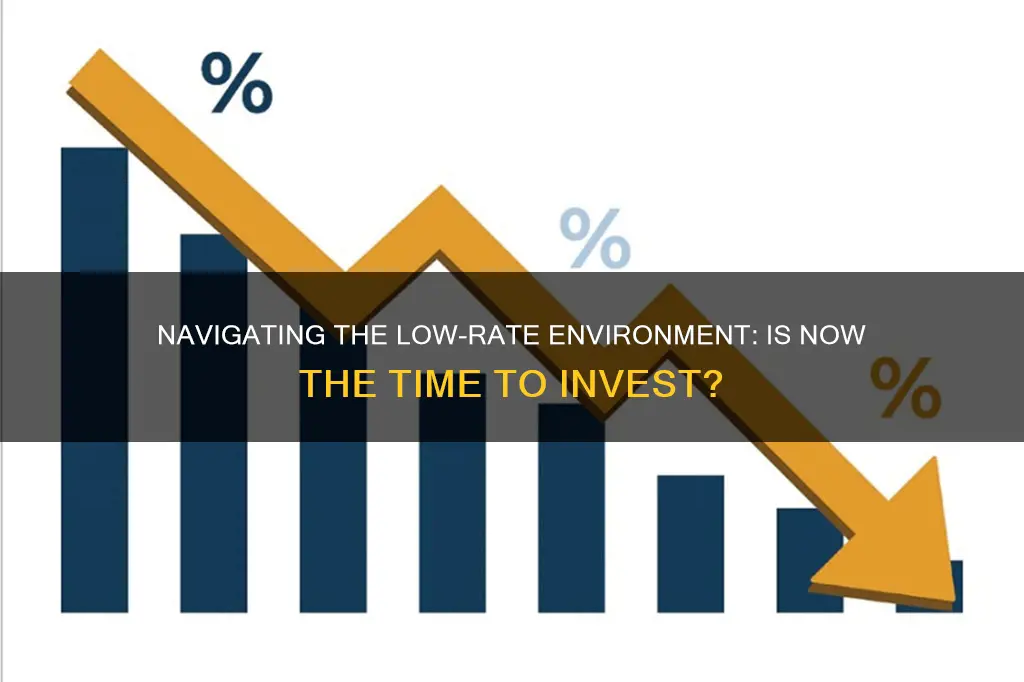
In today's economic landscape, where interest rates are at historically low levels, many investors are faced with a crucial decision: whether to invest despite the seemingly unattractive returns. This article aims to explore the pros and cons of investing during such a period, offering insights into the potential benefits and risks associated with this financial strategy. Understanding these factors can help investors make informed decisions about their portfolios and navigate the challenges of a low-interest-rate environment.
What You'll Learn
- Benefits of Low Rates: Lower rates encourage investment, boosting market activity and potential returns
- Historical Context: Past low-rate periods show increased market gains and asset appreciation
- Risk and Reward: Low rates often mean higher risk, but potential for greater returns
- Alternative Investments: Explore diverse options like bonds, real estate, and stocks during low-rate periods
- Long-Term Perspective: Investing when rates are low can lead to significant long-term wealth accumulation

Benefits of Low Rates: Lower rates encourage investment, boosting market activity and potential returns
Low interest rates can present a compelling opportunity for investors, offering a range of benefits that can significantly impact their financial journey. One of the primary advantages is the encouragement of investment. When interest rates are low, borrowing becomes cheaper, which can stimulate economic activity. This is particularly attractive for businesses, as it allows them to take out loans for expansion, research, and development at a reduced cost. As a result, the market becomes more active, with increased investment in various sectors, from technology startups to real estate ventures. This surge in investment activity can drive economic growth and create a favorable environment for investors.
For individual investors, low rates can be a strategic advantage. With savings accounts and fixed-income investments offering minimal returns, investors are prompted to seek higher yields elsewhere. This often leads to a shift towards riskier assets like stocks, bonds, and mutual funds, which can provide more substantial long-term gains. The increased market activity during low-rate periods can create a diverse range of investment opportunities, allowing investors to explore various sectors and asset classes. This diversity can help mitigate risks and provide a more balanced portfolio, which is essential for long-term wealth accumulation.
Another benefit is the potential for higher returns on investments. When interest rates are low, the cost of capital decreases, making it more affordable for companies to raise funds through debt or equity offerings. This can lead to increased corporate profitability and, subsequently, higher dividend payments or capital gains for investors. Additionally, low rates can encourage investors to take on more risk, as the potential rewards may outweigh the risks associated with certain investments. This increased risk-taking behavior can drive market growth and create opportunities for investors to capitalize on rising asset prices.
Furthermore, low interest rates can have a positive impact on the housing market. With mortgages becoming more affordable, people are more likely to enter the housing market, either as buyers or renters. This increased demand can drive up property prices, benefiting real estate investors and homeowners alike. The housing sector is a significant contributor to economic growth, and its performance during low-rate periods can have a ripple effect on other industries, creating a positive feedback loop for investors.
In summary, low interest rates offer a multitude of advantages for investors. They encourage investment, stimulate market activity, and provide opportunities for higher returns. During these periods, investors can strategically allocate their resources, explore diverse investment options, and potentially benefit from increased economic growth. While low rates may present challenges for fixed-income investors, they also create a favorable environment for those willing to take calculated risks, ultimately contributing to a thriving and dynamic investment landscape.
Franklin Templeton Investments: Navigating Exempt-Interest Dividends in Lacerte Software
You may want to see also

Historical Context: Past low-rate periods show increased market gains and asset appreciation
The historical context of low-interest rates provides valuable insights into the potential benefits of investing during such periods. When central banks lower interest rates, it often signals an economic environment where borrowing is cheaper, and the cost of credit is reduced. This can stimulate economic activity, encouraging businesses to invest and individuals to spend more. As a result, markets tend to thrive in these low-rate environments, leading to several favorable outcomes for investors.
One of the most significant advantages of investing when interest rates are low is the potential for increased market gains. During periods of low rates, investors often seek opportunities to maximize their returns. This is because low-interest rates can make traditional savings accounts and fixed-income investments less attractive due to their diminished returns. As a result, investors may turn to the stock market, real estate, or other alternative investments, driving up demand and potentially causing asset prices to rise. Historical data supports this notion, as stock markets have historically performed well when interest rates are low, often leading to substantial gains for investors over time.
Additionally, low-interest rates can contribute to asset appreciation. When borrowing costs are low, individuals and businesses are more inclined to take on debt, which can stimulate economic growth. This increased borrowing can lead to higher demand for various assets, including real estate, commodities, and even certain stocks. As a result, the value of these assets may appreciate, providing investors with significant returns. For instance, during the global financial crisis when central banks cut interest rates to historic lows, many investors saw their portfolios grow as asset prices rebounded and continued to rise in the subsequent years.
Furthermore, the historical context reveals that low-rate periods often coincide with economic expansions. When interest rates are low, businesses may expand their operations, leading to increased productivity and revenue. This can result in higher corporate profits, which, in turn, can drive up stock prices. Similarly, low-interest rates can encourage consumers to make purchases, boosting sales and potentially increasing the value of consumer-centric companies. As such, investors who identify these low-rate periods and make strategic investment choices may benefit from the overall market upswing.
In summary, the historical context of low-interest rates is a powerful indicator of potential investment success. Past periods of low rates have consistently shown increased market gains and asset appreciation. By understanding this relationship, investors can make informed decisions, potentially benefiting from the economic environment that low-interest rates create. This knowledge is particularly valuable for those considering investment strategies during times when central banks are actively managing interest rates.
Maximizing Returns: How Multiple Investments Can Boost Your Interest Earnings
You may want to see also

Risk and Reward: Low rates often mean higher risk, but potential for greater returns
When interest rates are low, it can be tempting to invest, as the potential for higher returns may seem more appealing. However, it's important to understand the risks associated with this strategy. Low interest rates often indicate a broader economic environment where borrowing is cheap, and this can lead to a variety of market behaviors that investors should be aware of.
One of the primary risks is the potential for higher volatility in the markets. When interest rates are low, investors might seek higher returns by taking on more risk, which can lead to increased market volatility. This volatility can cause the value of investments to fluctuate more rapidly, making it a challenging environment for those seeking stable, long-term growth. For instance, during periods of low interest rates, the stock market might experience rapid growth, but it can also correct quickly, leading to potential losses.
Another risk is the possibility of reduced returns on savings and fixed-income investments. With low interest rates, the returns on savings accounts, certificates of deposit (CDs), and other fixed-income securities tend to decrease. This can be a significant concern for those relying on these investments for income or those planning for retirement. As a result, individuals might need to reconsider their investment strategies to ensure they can still meet their financial goals.
Despite these risks, investing when interest rates are low can also present opportunities. One such opportunity is the potential for greater returns in the stock market. With low borrowing costs, companies might have easier access to capital, which can stimulate economic growth and potentially lead to higher stock prices. Additionally, certain sectors, such as technology and small-cap stocks, often perform well during periods of low interest rates as they are seen as growth-oriented investments.
In conclusion, while low interest rates can create a challenging environment for investors, they also present opportunities. It is crucial to carefully consider the risks, such as increased market volatility and reduced returns on savings, and to develop a well-diversified investment strategy that aligns with your financial goals and risk tolerance. Staying informed and regularly reviewing your investments can help you navigate these low-rate environments effectively.
Unraveling the Magic: How Investments Generate Interest
You may want to see also

Alternative Investments: Explore diverse options like bonds, real estate, and stocks during low-rate periods
When interest rates are low, many traditional investment vehicles may not offer the same attractive returns as they once did. This can be a challenging environment for investors, but it also presents an opportunity to explore alternative investment strategies. Diversifying your portfolio with various assets can help mitigate risks and potentially yield better long-term results. Here's an overview of some alternative investment options to consider during periods of low interest rates:
Bonds: One of the most well-known alternative investments is bonds. When interest rates are low, government and corporate bonds can become more appealing. Bond prices tend to rise as interest rates fall, providing an opportunity to purchase them at a discount. Bonds offer a steady income stream through regular interest payments, making them a reliable source of cash flow, especially for conservative investors. Municipal bonds, which are issued by local governments, can also be an attractive option as they often provide tax advantages, further enhancing their appeal during low-interest-rate environments.
Real Estate: Investing in real estate is another strategy that can thrive when interest rates are low. Real estate investment trusts (REITs) allow investors to gain exposure to the real estate market without directly purchasing properties. REITs are companies that own or finance income-producing real estate, and they offer a way to diversify across various property types, such as office buildings, malls, or residential complexes. Additionally, buying and holding real estate directly can be a lucrative strategy. As interest rates remain low, mortgage rates also tend to be low, making it an opportune time to secure financing for property purchases. This can lead to potential rental income or future capital appreciation.
Stocks and Equities: While stocks may not provide the same level of safety as bonds during periods of low interest rates, they can still be a valuable component of a diversified portfolio. When interest rates are low, the stock market can often benefit from increased liquidity and lower borrowing costs, which may drive up stock prices. Investing in a broad range of stocks across different sectors can help mitigate risks. Additionally, consider exploring international markets, as global companies may offer unique growth opportunities that are less correlated with domestic economic conditions.
Alternative Assets: Exploring alternative investments can be a strategic move when traditional options seem limited. This category includes assets like commodities, futures, options, and even peer-to-peer lending. For instance, investing in gold or other precious metals can provide a hedge against inflation, which often accompanies low-interest-rate environments. Cryptocurrencies and blockchain-based assets are also gaining traction, offering new avenues for investors seeking innovative opportunities.
In summary, low-interest-rate periods can be an ideal time to explore alternative investments. Bonds, real estate, stocks, and other diverse assets can provide opportunities to generate returns and manage risks effectively. It's essential to conduct thorough research, consider your risk tolerance, and consult with financial advisors to make informed investment decisions that align with your long-term financial goals.
Uncover the Magic: Tracking Your Compound Interest Investment Journey
You may want to see also

Long-Term Perspective: Investing when rates are low can lead to significant long-term wealth accumulation
When interest rates are low, many people might be tempted to avoid investing, fearing that the potential returns won't be worth the risk. However, adopting a long-term perspective can be a powerful strategy to build significant wealth over time. This approach is particularly beneficial for investors who are willing to commit to a long-term investment plan, as it can lead to substantial financial gains.
The key to success in this scenario lies in understanding the relationship between interest rates and investment returns. When interest rates are low, borrowing becomes cheaper, which can stimulate economic growth. This growth often translates to higher corporate profits and, consequently, increased stock market performance. As a result, investors can benefit from capital appreciation, especially in the stock market, as companies' values tend to rise. Additionally, low-interest rates can make fixed-income investments, such as bonds, less attractive, causing their prices to drop, which presents an opportunity for investors to buy them at a discount.
Over the long term, this strategy can be highly effective. By investing when rates are low, you can take advantage of the potential for higher returns as the economy recovers and interest rates gradually increase. This upward trend in rates can lead to a favorable environment for long-term investments, especially in the stock market, where companies have the potential to grow and generate substantial returns. For instance, historical data shows that the stock market has tended to perform well during periods of low interest rates, and this pattern can repeat itself over extended periods.
Furthermore, a long-term investment approach allows you to ride out short-term market fluctuations and economic cycles. While the short-term market may experience volatility, a well-diversified portfolio of long-term investments can weather these storms. As time passes, the power of compounding returns becomes evident, where your initial investments, along with the returns, generate additional returns, and so on. This effect can significantly boost your wealth over the years.
In summary, investing when interest rates are low can be a strategic move for those with a long-term vision. It provides an opportunity to benefit from economic growth, potential stock market gains, and the power of compounding. By maintaining a disciplined investment strategy and regularly reviewing and rebalancing your portfolio, you can make the most of this scenario and build a substantial financial future. This approach requires patience and a commitment to long-term financial goals, but the rewards can be substantial.
High Interest Rates: A Double-Edged Sword for Investment Spending
You may want to see also
Frequently asked questions
Low interest rates can stimulate the economy by encouraging borrowing and spending. This environment often leads to higher asset prices as investors seek better returns, making it an attractive time to invest.
While low rates can boost markets, prolonged periods of low rates may indicate a lack of attractive investment opportunities. Investors might be tempted to take on more risk, which could lead to potential losses if the market turns unfavorable. Diversification and a long-term investment strategy are crucial in such scenarios.
Bonds typically offer fixed returns, and when interest rates fall, existing bond prices tend to rise. This is because new bonds issued at lower rates become more attractive, causing older bonds with higher rates to increase in value. However, investors should be cautious as rising bond prices may not last indefinitely.
Yes, low interest rates can make stocks more appealing. With borrowing costs low, businesses may have easier access to capital, potentially boosting their growth. Additionally, when interest rates are low, investors might shift their focus to riskier assets like stocks, driving up their prices.
A common strategy is to invest in growth-oriented assets like stocks or sectors that benefit from low rates, such as technology or real estate investment trusts (REITs). Diversifying across different asset classes and regularly reviewing your portfolio can help manage risks and maximize returns during extended periods of low interest rates.







